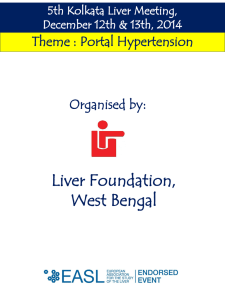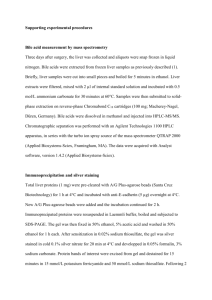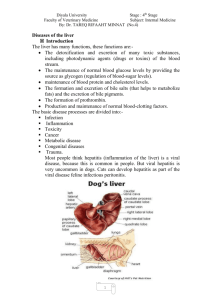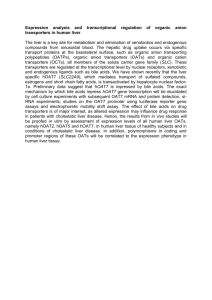liver cells
advertisement
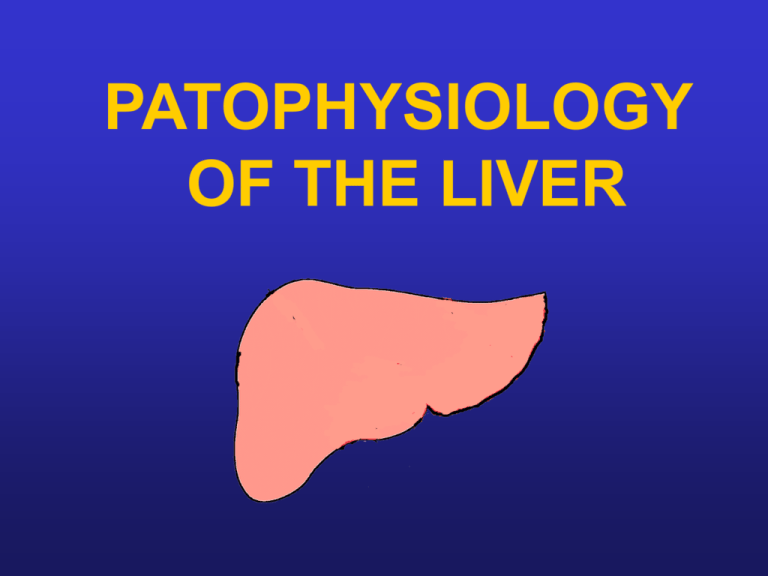
PATOPHYSIOLOGY OF THE LIVER Institute of Pathological Physiology Martin Vokurka mvoku@lf1.cuni.cz 2010/2011 LIVER CELLS • hepatocytes • reticuloendothelial cells Kupffer cells endothelia • hepatic stellate cells (HSC), Ito cell, lipocytes Hepatocytes – polarized cells • basolateral membrane (surface) – sinusoids, bloodstream • apical (canalicular) membrane – bile canaliculus Liver structure Blood flow * portal vein * hepatic artery * capillary fenestrations * low resistence Conditions for normal liver functioning • sufficient amount of hepatocytes • appropriate blood flow through liver: sufficient contact of cells with blood * Functional liver reserve * Capacity for regeneration Damage of the liver - disturbance of hepatocytes - death of hepatocytes - loss of liver parenchyme - activation of other liver cells - change of liver structure - liver blood flow disturbances Principle causes of liver damage • • • • • viruses alcohol circulatory disturbances metabolic diseases hepatotoxic substances incl. drugs • tumors • systemic diseases HBV cytokine production endotoxin ↑ gut permeability nutricious deficiency ETHANOL membrane alterations organels dysfunction immunol. stimulation cytochrome P450 induction disturbances of detoxification and inactivation metabolism acetaldehyde ↑ NADH/NAD ↑ FA synthesis ↓ beta-oxidation free radicals enzyme disturbances toxicity ↓ gluconeogenesis mitochondria disturbances etc. Circulatory disturbances * blood congestion right heart failure – nutmeg liver * hypoperfusion, e.g. due to shock Metabolic diseases • • • • • hemochromatosis porphyria Wilson’s disease glykogenosis thesaurosis Wilson’s disease (hepatolenticular degeneration) AR inherited disorder (1:30 000) of copper metabolism impairment of normal excretion of hepatic copper toxic accumulation of the metal in liver, brain and other organs low serum ceruloplasmin concentration Neuropsychiatric damage The entire March 1912 issue of Brain was devoted to S. A. Kinnier Wilson's description of familial hepatolenticular degeneration. On the left is one of Wilson's original patients, demonstrating the characteristic posture of the arms and hands and fixed facial features with involuntary mouth opening. On the right is the cut brain of one of Wilson's patients, showing bilateral degeneration of the lenticular nuclei. Kayser-Fleischer ring Hepatic disturbances - acute hepatitis - fulminant hepatitis - chronic active hepatitis - cirrhosis ATP7B gene (13th chromosome) P type, copper-transporting ATPase more than 40 mutant forms have been identified Hemochromatosis • disorder of iron storage • mostly AR inherited disease (almost 0,3% incidence with incomplete penetration) inappropriate increase in intestinal iron absorption • deposition of excessive amount of iron in parenchymal cells with tissue damage Porphyria inherited or acquired disorder of specific enzymes in the heme biosynthetic pathway with accumulation of porphyrins of their precursors some of them – mainly PCT (porphyria cutanea tarda) – represent higher risk of cirrhosis and even hepatocellular carcinoma Chemicals, toxins, drugs * tetrachlormethan and other solvants * faloidin * PARACETAMOL = ACETAMINOFEN * many others… !!! Liver reaction to damage damaging factors liver reaction liver disease RESOLUTION Activated HSC Quiescent HSC cytokine receptors cytokine production retinoid loss muscle α actin expression collagenase production extracellular matrix degradation collagen production proliferation increased contractility fibrogenesis leukocyte chemotaxis PDGF, TGFβ autocrinne cytokine secretion Kupffer cells IL-6 hepatocytes Apoptosis TIMPs TGFβ ET-1 MMP-2 PDGF MCP-1 damage INITIATION PERPETUATION PROGRESSION Hepatitis Etiology * viruses - clascical (A,B,C,D,E…) * other viruses and bacteria (e.g. CMV, Leptospira) * alcoholic hepatitis Clinical forms * acute (ev. fulminant) * chronic (B, mainly C) - persistent (CPH) - active (CAH) – progression acute recovery inaparent persistence chronic activity progression cirrhosis carcinoma ? internal and external factors Liver steatosis, steatohepatitis Etiopathogenesis Alcoholic * energy * metabolic changes * cytochrome induction * increased TNFα production Nonalcoholic steatohepatitis (NASH) * insulin resistence, obesity, DM 2, hyperlipoproteinemia * malnutrice, profound weight loss * toxic substances, drugs ADIPOUS TISSUE INSULIN RESISTENCE HYPERINSULINEMIA FFA ↑ FFA DIETARY TG ↑ TG LIPOPROTEINS (VLDL) nutricious deficiency insulin mitochondrial dysfunction ↓ β oxidation carnitine deficiency FA synthesis lipid peroxidation oxygen radicals glykolysis Krebs cykle LPS cytokines Damage, inflammation Liver cirrhosis * hepatic injury * fibrosis * nodular regeneration * irreversible distortion of normal liver architecture * blood flow disturbances * loss of parenchyma Hepatocellular carcinoma (HCC) * mainly occurs in cirrhosis * etiology is largely common with cirrhosis - viruses (HBV and HCV!) - alcohol a toxins (e.g. aflatoxins, mycotoxins) - hemochromatosis, porphyria - combination * studies on molecular level Clinical features of liver diseases 1) progressive hepatocellular dysfunction and loss of hepatocytes 2) disturbances of blood flow through liver - portal hypertension Portal hypertension Types: * prehepatic * (intra)hepatic * posthepatic Intrahepatic PH: * presinusoidal * sinusoidal * postsinusoidal P= Q × R pressure flow resistance Mechanisms: a) increased flow through portal region caused by vasodilation and by hyperkinetic circulation b) increased resistence in liver circulation - mechanical due to structural changes and fibrosis in liver - functional (endothelial dysfunction, HSC activation, elevated production of vasoconstrictory endothelin, decreased production of vasodilatory nitric oxid – NO) architectural disturbances (fibrosis, scarring etc.) functional alterations (sinusoidal and extrasinusoidal contractile elements) increased hepatic resistance R PORTAL HYPERTENSION splanchnic vasodilatation increased portal blood flow Q effective hypovolemia and reduced central volume activation of endogenous vasoactive systems (noradrenalin, angiotensin etc.) Consequences and main clinical manifestations of portal hypertension * portocaval (portal-to-systemic) shunting * blood stagnation in abdomen organs * gastointestinal bleeding * hepatic (portosystemic) encefalopathy (PSE) * ascites * splenomegaly * circulatory disturbances * hepatorenal syndrome * spontaneous bacterial peritonitis PORTAL HYPERTENSION GIT mucosa malabsorption metabolic and nutritional sequelae collaterals toxic products circulation disturbances splenomegaly bleeding cytopenia portosystemic shunts encephalopathy ascites Enlargment of blood vessels that anastomose with the portal vein – varices * bleeding * blood shunting directly to systmic circulation - nutrients - gastrointestinal hormones - drugs - toxic substances exogenous and gut-derived Disturbances of hemostasis • coagulopathy synthesis of coagulation factors • thrombocytopenia splenomegaly… • decreased clearance of activated factors Hepatic encephalopathy • acute LF • portosystemic encephalopathy Pathogenesis has not been completely elucidated yet, the role of several factors is supposed • ammonia and other gut-derived substances • disturbances in blood-brain barrier (BBB) permeability (cytokines – TNF-α, NO…) • disturbances in neurotransmission (↑GABA, ↓glutamate, ↑endogenous benzodiazepins, neurosteroids) • false neurotransmiters (e.g. octopamin) • increase of benzodiazepin receptors (peripheral type) in astrocytes • changes in aminoacid spectrum (↑aromatic, ↓branched) • osmotic changes and brain edema in hepatic encefalopathy during acute LF • role of proinflammatory cytokines (IL-1, IL-6, TNF-α) on blood-brain barrier permeability and on endothel in brain vessels (e.g. induction of NO production with changes in brain circulation) • other: deposits of manganese in gl. pallidus, phenol, short-chain fatty acids... systemic circulation NH3 NH3 NH3 BRAIN encefalopathy LIVER NH3 metabolism pH glutamine portal hypertension hepatocyte failure urea pH normal LEDVINY urine BLEEDING NH3 GUT bacteria source for amoniogenesis proteins food endogennous CIRCULATION portal hypertesion gut permeability NH4+ NH3 H+ passage (time) source fof ammoniogenesis proteins bacteria GUT food bleeding immunity lactulosis ATB low protein diet treatment/prevention of bleeding food proteins tyrosin DOPA dopamin noradrenalin fenylalanin normal synthesis in the nervous tissue decarboxylation in the gut tyramin octopamin β-fenyletanolamin false neurotransmitters of sympathic nerves DISTURBANCE OF BRAIN FUNCTION/METABOLISMS Precipitating factors: • bleeding, • proteins, • constipation, • renal failure with blood urea increase (source for ammonia generation in gut), • drugs, • electrolyte imbalance, • infection, surgery etc. CIRCULATORY DISTURBANCES PORTAL HYPERTENSION SPLANCHNIC VASODILATATION (NO etc.) SYSTEMIC UNDERFILLING VASOCONSTRICTION IN OTHER ORGANS, MAINLY IN THE KIDNEYS FLUID RETENTION CIRCULATORY CHANGES – SYSTEMIC CIRCULATION DECREASE OF SYSTEMIC RESISTANCE INCREASE OF CARDIAC OUTPUT HYPOTENSION TACHYCARDIA HYPERKINETIC CIRCULATION portal hypertension splanchnic arteriolar vasodilation increase of splanchnic capillary pressure and permeability increased lymph formation arterial hypotension and vascular “underfilling” stimulation of - sympathic nerves - ADH - RAAS water and sodium retention ASCITES incomplete compensation compensation normal circulation ASCITES Mechanisms of origin: a) portal hypertension b) hypoalbuminemia c) circulatory changes (vasodilation, hyperkinetic circulation) d) water and sodium retention – key role of the kidney in ascites formation e) lymphatic vessels disorders These mechanisms are responsible also for edema (except for portal hypertension). lymphatic drainage ascites fluid exchange (filtration > resorption) decreased oncotic pressure A vasodilatation V portal hypertension hypalbuminemia vasodilation ↓effective blood volume Circulation portal hypertension volumoreceptors Fluid retention ↑sympathetic activity ↑ renin-angiotensinaldosteron intrarenal changes ↑ ADH Water+mineral changes poruchy svalů a nervů dysmotilita GIT K+ hypokalemia ↓ sensitivity to ANF water and sodium retention ↓ renal perfusion ASCITES EDEMA digestive disorders ABB metabolic alkalosis changes in NH3 metabolism dilutional hyponatremia Na+ HEPATORENAL SYNDROME vasodilation hypoalbuminemia ↓ effective plasmatic volume volumoreceptors/baroreceptors ↑ sympatic system portal hypertension ↑ R-A-A-S ASCITES ↑ ADH ↓ sensitivity for ANF water/sodium retention changes in renal perfusion changes in water/minerals/ABB secondary hyperaldosteronism hepatorenal syndrome EDEMA Sequelae of ascites: a) increase in body weight (might be another complication in general bad status) b) diaphragm elevation (decreased lung vital capacity) c) negative impact on GIT d) mechanical influencing abdomen wall, hernias etc. HEPATORENAL SYNDROME (HRS) portal hypertension splanchnic vasodilatation severe arterial underfilling stimulation of vasoconstrictive mechanisms increased production of splanch. VD substances BP decrease vasoconstriction in the brain and the limbs vasoconstriction in the kidneys renal vasoconstrictors prevail over renal vasodilatatory mechanisms (mainly prostaglandines) HRS HEPATORENAL SYNDROME (HRS) Renal failure in patients with advanced (chronic) liver disease, the histological appearance of the kidneys is normal, they can be transplanted The hallmark of HRS is vasoconstriction in the renal circulation due to sympathic system and RAAs activation. Endothelins a leukotriens might be also involved. The vasoconstrictor systems are activated as a response to vasodilation induced by e.g. NO, which persists in splanchnic regions while in the kidneys leads to vasoconstriction . Protective action on kidney perfusion have prostaglandins (caution with many drugs !) HEPATORENAL SYNDROME (HRS) - oligoanuria - increase of serum creatinine and urea - decrease of GF below 20 ml/min - tubular functions are preserved - worsening response on diuretic therapy - sodium and water retention, edema, ascites, dilutional hyponatremia Hepatorenal syndrome (HRS) type I – rapid progression of renal functions with increase of serum creatinin type II – slower onset The syndrome is characterized by functional changes in kidney; the histology is normal Gastrointestinal&digestion disorders • Portal-hypertensive gastropathy (PHG): dilated vessels in the mucosa and submucosa in the absence of inflammation, leading to small or less frequently large erosions. No clinical manifestation but bleeding in cases with large erosions. • Gastric acid secretory activity is reduced, whereas the gastric mucosal barrier is impaired. • Gastric mucosal haemodynamics: whether „overflow“ (i.e. active congestion) or „stasis“ (i.e. passive congestion) causes gastric mucosal hyperaemia is not known • Disorders of bile secretion – malabsorption of fat + fat-soluble vitamins • Impaired resorption Hormonal disturbances Altered hormone clearance in liver – decreased removal of free steroid hormones from blood and their inactivation, decrease in inactivation of insulin/glucagon Steroid hormones clearance is diminished – increased peripheral aromatization of androgens to estrogens: gynecomasty in man, testicular atrophy, sexual disturbances… Decrease aldosterone metabolism contributes to the secondary hyperaldosteronism Icterus (jaundice) JAUNDICE bilirubin heme hemoglobin hemolysis transport (albumin) entry into hepatocyte injury/death hepatocytes cirrhosis hepatitis decreased amount of liver parenchyma Gilbert‘s syndrome CONJUGATION neonatal icterus Crigler-Najjar sy Rotor sy excretion from hepatocyte Dubin-Johnson sy (cMOAT) familiar cholestasis bile transport cholestasis Cholestasis Bile production and secretion blood Liver * transport mechanisms in hepatocytes * structural hepatocyte integrity * energy Bile flow * intrahepatic biliary ducts * extrahepatic biliary ducts bile gut Principle bile components * water * bile salts * phospholipides * cholesterol and other steroids * minerals * endogenous substances * exogennous substances incl. drugs, toxins etc. Important - fluidity Hepatocyte and transporters * hepatocyte damage incl. energetic metabolism * inborn defects of transporters * competition between various substances during transport * change in gene expression of transporters Hereditary disorders * progressive familiar intrahepatic cholestasis (PFIC) - type 1 - MDR3 - type 2 - BSEP * Dubin-Johnson syndrome - cMOAT Canalicular disorders * cholangitis incl. autoimmunity * granulomas * ischemia * cystic fibrosis * tumors … Extrahepatic disorders * cholelithiasis (stones) * tumors Consequences * bile stagnation in the * lack of bile in the intestine Damage to hepatocytes and liver - bile acids * detergent action, membrane damage * lipase activation * vasoactive action * interference with metabolism, transduction * incorporation into membranes, covalent binding to proteins * apoptosis * immunomodulatory functions - bilirubin mitochondrial uncoupling jaundice (icterus) - leukotriens hemodynamic effects inflammation - copper lipid peroxidation - cholesterol change in membrane fluidity Sequelae: biliar cirrhosis Lack of bile in the intestine * lipid digestion disturbed * malabsorption, incl. fat-soluble vitamins (hypovitaminosis) - calcium, bones (D) - coagulopathy (K) - damage to epithelium, vision disturbances etc. (A) * acholic stools Clinical manifestation * jaundice * pruritus (bile acids, endorfins) * pain (extrahepatic biliary obstruction) * sequelae of disturbances of digestion Gilbert’s syndrome non-conjugated familiar hyperbilirubinemia incidence: several % in population, mainly men jaundice can manifest during stress, fasting and can simulate hepatitis genetic changes in promotor sequence of gene for UDP-glucuronyltransferase. decrease in gene expression increase in repetitive sequences TA in TATAA region of promotor, which decreases binding of transcription factors The End (+ supplement) Cytokine action influence regeneration × apoptosis fibroproduction origine: inflammation, endotoxin source: parenchymatous and nonparenchymatous cells autocrinne and paracrinne secretion Intestinal changed permeability and action of endotoxin long time influence of alcohol portal hypertension endotoxin penetrates to portal blood and stimulates macrophages to production of cytokines, NO, oxygen radicals Basolateral membrane * sodium-potassium ATPase * potassium channel * sodium dependent transport (proton, bicarbonate) * NTCP – sodium-taurocholate cotransporter (primary carrier for conjugated bile-salt uptake from portal blood) * OATP1,2 – (sodium independent) organic-anion transporter (multispecific carrier: bile salts, org. anions, bilirubin, estrogens …) Canalicular (apical) membrane * MDR1 – multidrug-resistance-1 P-glycoprotein (ATP depend. excretion of large org. cations, toxins, xenobiotics) * MDR3 – multidrug-resistance-1 P-glycoprotein (phospholipide transport) * BSEP – bile-salt export pump (ATP-depend. bile salt transport into bile, stimulation of bile flow) * MRP2/cMOAT – canalicular multispecific organic-anion transporter (ATP-depend. transport of organic anions incl. bilirubin diglucuronide) Principle functions of the normal liver * energy metabolism and substrate interconversion * protein synthetic functions: plasma proteins incl. albumin and coagulation factors * solubilization, transport, storage * protective and clearance functions, detoxification, inactivation Mechanisms of virus liver damage * direct - cell necrosis (HAV) * indirect, mediated by immune mechanisms, apoptosis, Fas system Mechanisms of liver damage Cell damage Cell death necrosis apoptosis the way of cell death druh may depend on intensity of stimulus and of status of liver cells (ATP, antioxidative mechanisms etc.) Provoking mechanisms Oxidative stress - intracellular in hepatocyte: 2-5% oxygen oxidative mechanisms in mitochondria detoxification reactions (cytochrom P450) increased due to TNFα, ischemia/reperfusion etc. - intercellular - activated phagocytes, leukocytes nitric oxide Viruses Toxins Cytokines (e. g. TNFα) final outcome depends on cell status: depletion of antioxidants (e.g. by alcohol) leads to cell death, meanwhile with their abundance the cytokine action might be proliferative Fibroproduction key role: non-parenchymatous cells autocrinne and paracrinne stimulation HSC 15 % of cells in liver Disse space retinoid storage heterogenous group of cells, embryon. from neural crest activation – proliferation / fibroproduction / contractility Initiation from damaged hepatocytes, endothelial cells, Kupffer cells, change in extracellular matrix production of oxygen radicals Perpetuation production of various cytokines and enzymes dividing of HSC, contractility, collagen production, change in extracellular matrix, chemotaxis of HSC and leukocytes, loss of retinoids Resolution is the deactivation possible ? – IL-10 apoptosis Sodium&Water Balance, Acid-Base Balance Mechanisms: a) hypoalbuminemia b) circulation changes (vasodilatation of systemic and splanchnic vascular bed, hyperkinetic circulation, development of vasoconstriction in kidneys) c) secondary hyperaldosteronism • water retention decreased capacity of patients in excreting water ADH, diminished production of prostaglandins in kidney, decreased delivery of filtrate to distal parts of nephron and collecting tubules • sodium retention - „undefilling“ hypothesis – low renal perfusion due to diminished effective intravascular volume (hypoalbuminemia, systemic and portal circulatory changes with vasodilation and hyperkinetic circulation), developing vasoconstriction in renal circulation and then funtional fluid and sodium retention due to activation of the system renin-angiotensin-aldosteron (secondary hyperaldosteronism) and ADH, activation of sympathetic nerves etc. - „overflow“ hypothesis: primary is increased soidum resorption (probably both in proximal and distal tubules) Hyponatremia (dilutional) is very often observed together with general increased amount of sodium in body. Hyponatremia reflects the water retention. • hypokalemia • metabolic alkalosis (metabolic acidosis develops in terminal phases), in connection with hypokalemia (hyperaldosteronism); depletion of kalium, protons enter the cells, intracellulary is acidosis (!) Protein metabolism decreased syntesis of albumin (normally 12 g/day, about 20 days half-life), coagulation factors, transport proteins oxidative deamination and transamination of amino acids Urea cycle Synthesis of urea from ammonia in periportal hepatocytes; requires energy (ATP); key enzyme – carbamylphosphate synthetase Synthesis of urea is connected with regulation of acid-base balance Alkalemia increases the activity of carbamylphosphate synthetase, the synthesis of urea is increased, synthesis of glutamine is decreased; in kidneys NH3 (the substrate for urea synthesis) is resorbed + proton Acidemia inhibits urea synthesis, ammonia is rather transformed in perivenous hepatocytes to glutamine which is transported to kidneys (NH4+ is excreted to urine) Carbohydrate metabolism Liver plays role of „glucostat“ (glykogen storage, glukoneogenesis, target organ of acting and inactivation of hormons) chronic LF – cirrhosis: often insulin resistence or diabetes terminal phase or acute severe LF – hypoglycemia

